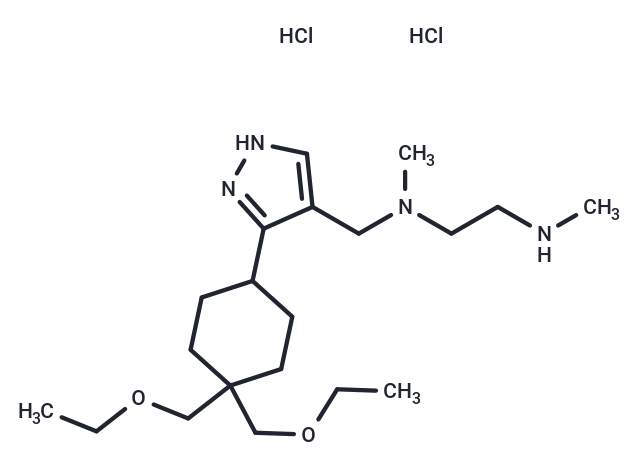Shopping Cart
- Remove All
 Your shopping cart is currently empty
Your shopping cart is currently empty

GSK3368715 dihydrochloride (EPZ019997 dihydrochloride) is an orally active and potent inhibitor of type I protein arginine methyltransferases (PRMTs), including PRMT1, PRMT3, PRMT4, PRMT6, and PRMT8. It exhibits anticancer and antitumor activity and can be used to study advanced solid tumors.

| Pack Size | Price | Availability | Quantity |
|---|---|---|---|
| 1 mg | $56 | In Stock | |
| 1 mL x 10 mM (in DMSO) | $94 | In Stock |
| Description | GSK3368715 dihydrochloride (EPZ019997 dihydrochloride) is an orally active and potent inhibitor of type I protein arginine methyltransferases (PRMTs), including PRMT1, PRMT3, PRMT4, PRMT6, and PRMT8. It exhibits anticancer and antitumor activity and can be used to study advanced solid tumors. |
| Targets&IC50 | PRMT1:3.1 nM, PRMT6:5.7 nM, PRMT3:48 nM, PRMT4:1148 nM, PRMT8:1.7 nM |
| In vitro | In the majority of 249 cancer cell lines representing 12 tumor types, GSK3368715 dihydrochloride (EPZ019997 dihydrochloride) exhibits 50% or more growth inhibition relative to DMSO-treated cells[1]. |
| In vivo | GSK3368715 dihydrochloride (EPZ019997 dihydrochloride) markedly inhibits the growth of BxPC3 xenografts at all tested doses, achieving tumor growth reductions of 78% and 97% at 150 mg/kg and 300 mg/kg, respectively[1]. |
| Alias | GSK3368715 2HCl, EPZ019997 dihydrochloride, EPZ019997 2HCl |
| Molecular Weight | 439.46 |
| Formula | C20H40Cl2N4O2 |
| Cas No. | 1628925-77-8 |
| Smiles | Cl.Cl.CCOCC1(COCC)CCC(CC1)c1n[nH]cc1CN(C)CCNC |
| Relative Density. | no data available |
| Storage | store at low temperature,store under nitrogen | Powder: -20°C for 3 years | In solvent: -80°C for 1 year | Shipping with blue ice. | |||||||||||||||||||||||||||||||||||
| Solubility Information | H2O: 100 mg/mL (227.55 mM), Sonication is recommended. DMSO: 100 mg/mL (227.55 mM), Sonication is recommended. | |||||||||||||||||||||||||||||||||||
Solution Preparation Table | ||||||||||||||||||||||||||||||||||||
H2O/DMSO
| ||||||||||||||||||||||||||||||||||||

Copyright © 2015-2024 TargetMol Chemicals Inc. All Rights Reserved.